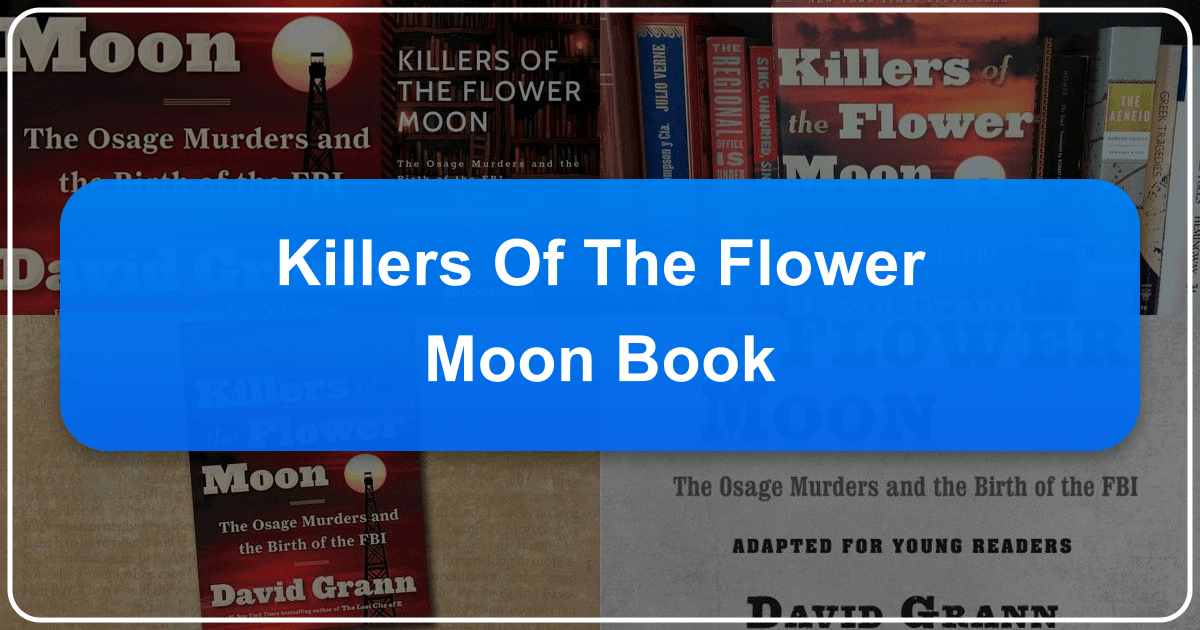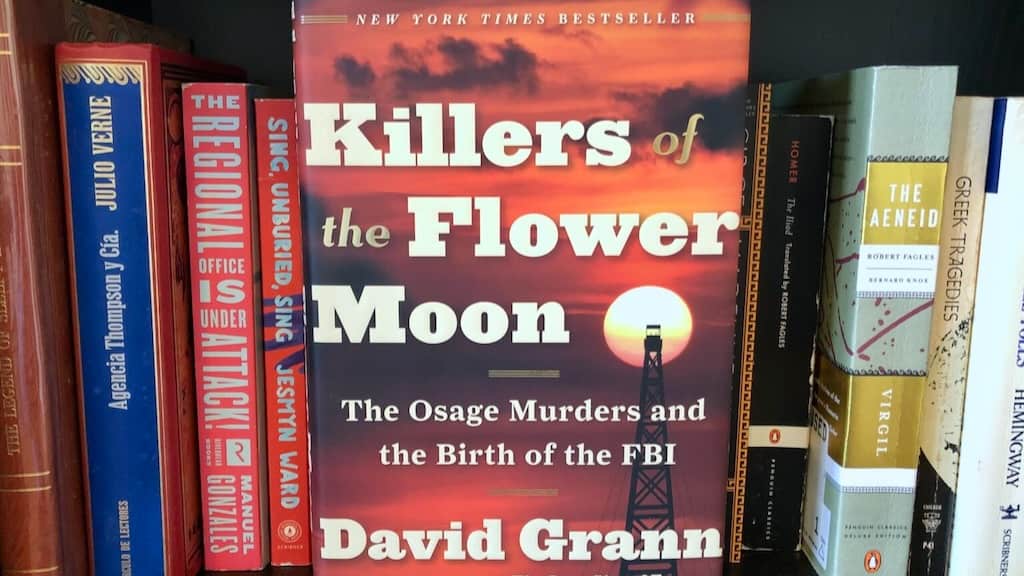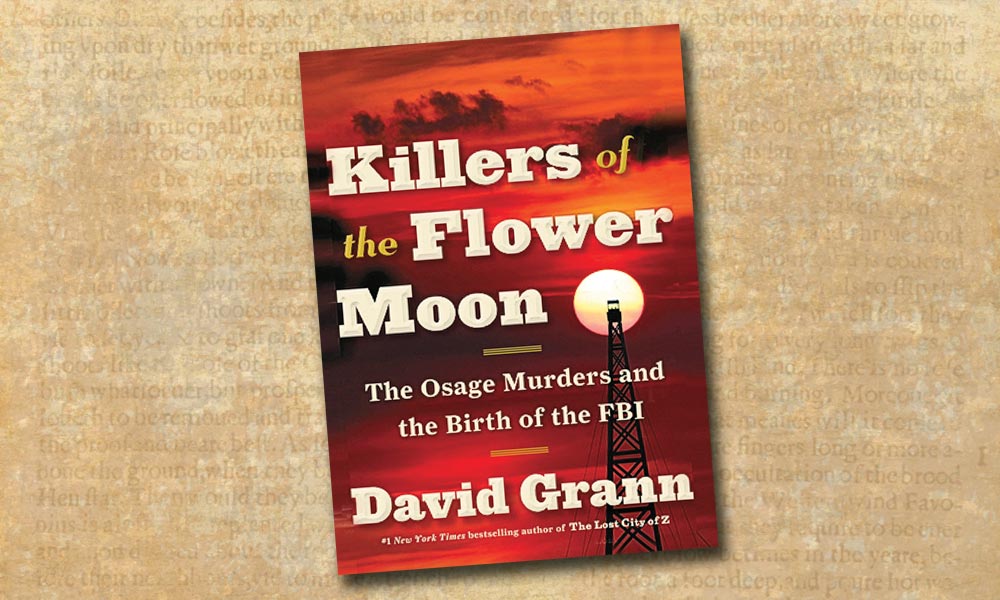Killers of the Flower Moon Book: A Comprehensive Review

David Grann’s Killers of the Flower Moon: The Osage Murders and the Birth of the FBI is a gripping narrative nonfiction work that explores a dark and largely forgotten chapter of American history. The book delves into the systematic murders of members of the Osage Nation in Oklahoma during the 1920s, a period marked by immense wealth generated from oil discoveries on their land and the subsequent greed and corruption that led to a reign of terror. This in-depth review will examine the book through various lenses, covering its genre, author, educational value, cultural impact, and its place within the broader context of literature and history.

Genre and Literary Style
Killers of the Flower Moon transcends simple categorization. While firmly rooted in narrative nonfiction and true crime, its meticulous research and compelling storytelling techniques elevate it to a level often associated with literary fiction. The book masterfully blends investigative journalism with character-driven narratives, creating a suspenseful and emotionally resonant reading experience. Grann’s writing style is clear, concise, and evocative, allowing him to present complex historical information in an accessible and engaging manner. The pacing is carefully constructed, building suspense and gradually revealing the shocking depths of the conspiracy. This makes the book appealing to a wide audience, not just those interested in true crime or historical nonfiction but also to readers who enjoy well-crafted narratives with compelling characters and plot twists. The genre could be further described as historical investigative journalism, true crime, and social commentary.

Narrative Structure and Techniques
Grann structures the narrative skillfully, dividing it into three distinct parts:
-
The Osage Perspective: This section introduces the reader to the Osage Nation, their newfound wealth, and the tragic circumstances that befall Mollie Burkhart’s family. This section humanizes the victims, emphasizing their lives and losses.
-
The FBI Investigation: This part focuses on the investigation led by Tom White, a former Texas Ranger working for the fledgling FBI. The detailed account of the investigation provides insights into the early days of the FBI and the challenges faced in solving such a complex crime. The description of the challenges faced by investigators emphasizes the vast conspiracy and widespread corruption that enabled the murders to occur for such an extended period.

- Grann’s Investigation: Finally, Grann recounts his personal journey of researching and writing the book, including the discovery of previously overlooked evidence and details about the murders and their context in the broader American social landscape.
These different viewpoints are interwoven effectively to provide an enriched understanding of the events and their historical significance. Grann uses a variety of narrative techniques, including vivid descriptions, dialogue, and character development, to immerse the reader in the story. This approach moves seamlessly from a clear factual reporting style to more descriptive, evocative prose that keeps the narrative engaging.
The Author: David Grann
David Grann is a renowned American journalist and author known for his meticulous research and captivating storytelling abilities. His previous works, such as The Lost City of Z and The Wager, have achieved similar acclaim, establishing Grann as a master of the narrative nonfiction genre. Grann’s background in investigative journalism is evident in Killers of the Flower Moon. The book’s extensive research, including the careful analysis of historical documents and records, alongside the incorporation of numerous interviews with descendants of the victims, gives considerable weight to the narrative.
Grann’s Writing Style and Approach
Grann’s approach is characterized by his immersive style, which allows the reader to fully experience the historical setting and the lives of the individuals involved. His writing is engaging and accessible, making complex historical events understandable even to readers with little prior knowledge of the subject matter. The book’s extensive research base and the author’s clear commitment to historical accuracy underscore Grann’s rigorous journalistic approach. This commitment gives considerable weight to the narrative and adds to the book’s credibility as an important historical record.
Educational Value and Life Lessons
Killers of the Flower Moon offers significant educational value, providing a detailed account of a lesser-known but pivotal event in American history. It sheds light on:
-
The History of the Osage Nation: The book offers a nuanced perspective on the Osage people, their culture, and their struggle against systemic injustice. The details about the historical treatment of Native Americans in the United States provide valuable context to the murders and their underlying causes.
-
The Early Days of the FBI: Grann’s narrative provides a unique glimpse into the initial stages of the FBI’s development, highlighting both its successes and shortcomings in handling the complex investigation. The description of the difficulties faced by investigators in the 1920s highlights the evolution of investigative techniques.
-
Systemic Racism and Greed: Killers of the Flower Moon serves as a stark reminder of the devastating consequences of systemic racism and unchecked greed. The book demonstrates how institutional racism and powerful individuals were able to take advantage of a vulnerable population.
Life Lessons and Themes
The book’s narrative explores several enduring themes, including:
-
Justice and Injustice: The book highlights the long and arduous pursuit of justice for the victims of the Osage murders and how this pursuit is impacted by the pervasive racism and corruption of the era. The complexities of the case and the difficulties in attaining justice raise important ethical questions.
-
Power and Corruption: The narrative exposes the corrosive influence of power and corruption, showcasing how individuals and institutions colluded to exploit and harm the Osage people. The book describes how the lack of accountability and the pervasive corruption allowed the crimes to persist.
-
Resilience and Perseverance: Despite facing immense suffering, the Osage people demonstrated remarkable resilience in their fight for justice and recognition. Their struggles and their subsequent perseverance in the face of adversity serve as an inspiring example.
-
The Importance of Historical Awareness: The book underlines the vital need to recognize and understand the past, both to learn from past mistakes and to prevent similar atrocities from happening again. The importance of historical context in understanding contemporary social justice issues is emphasized.
Libraries and Archival Resources
The meticulous research underpinning Killers of the Flower Moon indicates extensive reliance on various library and archival resources. Grann’s in-depth examination of the events necessitates the careful study of historical records, legal documents, and personal accounts. The book’s thoroughness, including the extensive source notes and bibliography, attests to Grann’s use of a wide range of archival materials. Access to these records and their careful analysis are key to the book’s success.
Cultural Impact and Adaptations
Killers of the Flower Moon has had a substantial cultural impact, prompting renewed conversations about systemic racism, Native American rights, and the complexities of justice. The book has won various awards, including the Edgar Allan Poe Award, and has been nominated for others, such as the National Book Award. Its widespread critical and popular acclaim has brought the tragic events surrounding the Osage murders into the public consciousness, increasing awareness of a dark chapter of American history.
Adaptations and Media Attention
The immense success of the book has led to its adaptation into a major motion picture directed by Martin Scorsese and starring Leonardo DiCaprio, Lily Gladstone, and Robert De Niro. The film adaptation further amplified the book’s cultural impact, bringing the story to a wider audience and generating significant discussion about the issues raised within the narrative. The media attention surrounding the film highlights its impact on contemporary culture and discussion of American history.
Conclusion
Killers of the Flower Moon is more than a true crime narrative; it is a powerful work of historical investigative journalism that exposes a hidden tragedy and profound injustices. Grann’s masterful storytelling, meticulous research, and the book’s enduring themes make it a significant contribution to both the literary and historical landscape. Its lasting impact is evident in the renewed public awareness of the Osage murders, the ongoing conversations about social justice, and the powerful film adaptation that brought this compelling narrative to a wider audience. The book’s blend of genres and its exploration of multiple themes make it a compelling and thought-provoking read that deserves to be widely read and studied. Lbibinders.org is a valuable resource for further exploration of the topics and themes discussed in this book.